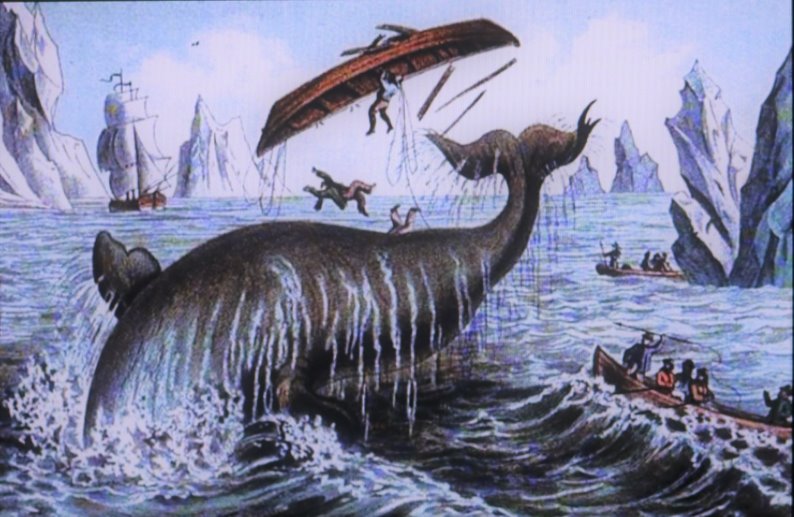We present thrilling news about these whale species:
Gray whales Blue whales Humpback whales Sperm whales Northern bottlenose whales
Gray whales, Eschrichtius robustus
Whale hunters were frightened of gray whales. They were considered to be extremely aggressive.
The whalers went out with small rowing boats, in order to ram their harpoons into the animal´s bodies. Of course the whales fought for their lives and attacked their slaughterers. Many boat crews became victims of these lashing tailstrokes, with whom the whale mothers defended themselves and their calves.
But in this part of the world the whalers had an easy hunt. There are three big lagoons at the Pacific side of Baja California, to where the gray whales migrate every year: Bahia Magdalena, San Ignacio and Ojo de Liebre. Here the mothers give birth to their offspring, others are mating. For the whalers in the old times a save occasion: They just had to wait at the entrances of the lagoons. Their prey would swim directly into their harpoons.
Even when the whaling was forbidden some 50 years ago, the fishermen didn´t trust themselves to go out. They were afraid of getting struck to death by the "devil fish".
Pachico Mayoral was the first one, who dared to row out one day into the lagoon, together with a colleague, and being very hungry. Suddenly a big gray whale appears directly beside his boat. Pachico is frightened to death. He is dumbfou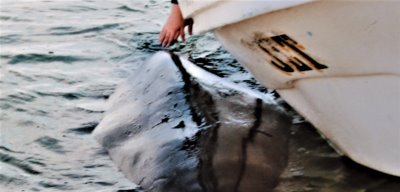 nded by what he sees: The whale huddles against the boat and remains there. What does he want? Will he lash out with his tail the next moment? Both carefully and scared they row back to the shore. The whale accompanies them for a while.
nded by what he sees: The whale huddles against the boat and remains there. What does he want? Will he lash out with his tail the next moment? Both carefully and scared they row back to the shore. The whale accompanies them for a while.
This Pachico has to consider for awhile. Was this just a singular incident or are those animals not as dangerous as it is being told? Little by little the fisherman recognizes, that these gray whales are actually harmless. That they are even looking for contact. „If they come to the boat and you don´t pet them, they swim away", Pachico says. The whale mothers come with their newborn, as if they would proudly present their offspring.
Here at the lagoons they feel protected. The little calves train their muscles during the winter months in order to be fit for the long and dangerous journey northwards. On their way they could easily meet up with killer whales (picture below).
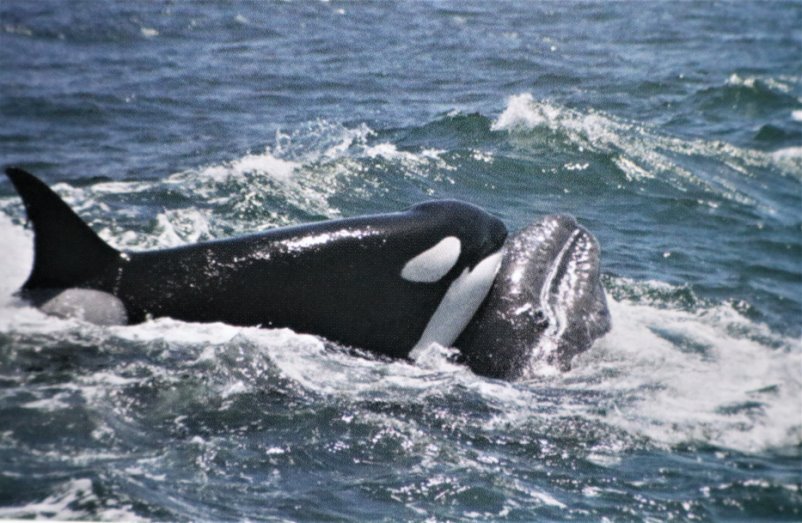 The killer whale nuckles the blowhole of a gray whale calv, in order to prevent it from breathing.
The killer whale nuckles the blowhole of a gray whale calv, in order to prevent it from breathing.
Before the killers can drown a gray whale calv, they have to separate it from its mother. That is quite difficult and very dangerous, because gray whale mothers defend their babies aggressively, lashing about with their bonebreaking tails.
Gray whales often swim close to the coast, for two reasons. First of all to be less attackable, since killer whales cannot drown a young one so easily in shallow water.
Second, the gray whales have a specific feeding technique. They plow along the bottom of the sea - mouth wide open, always on their right hand side - and suck in the sediments through their short baleens, in order to filter out small animals from the ground. This is probably the reason why their snouts are being covered with barnacles (picture below).
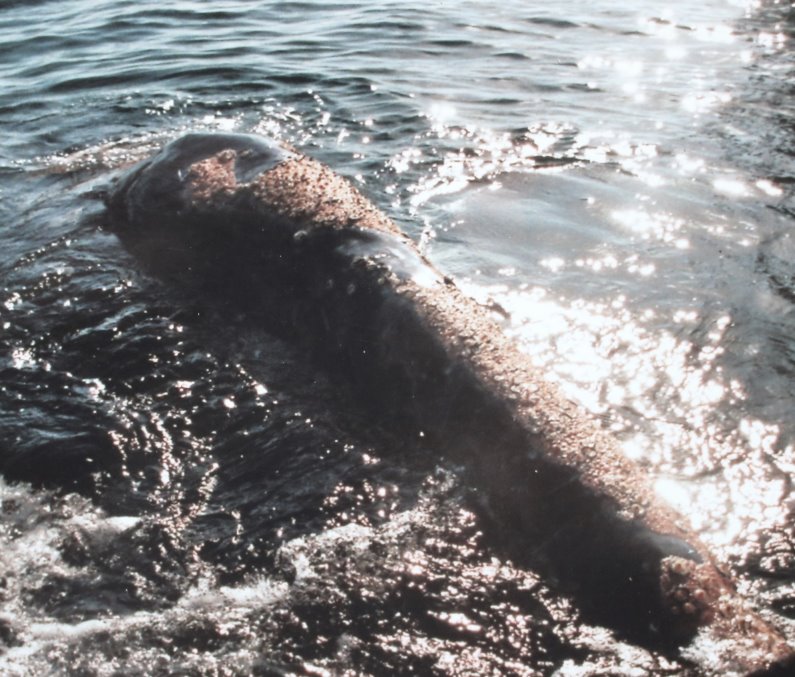
What makes gray whales travel to the lagoones of Baja California since thousends of years? Quite simple, the calm waters are especially appropriate for the upbringing of their newborn. They need warm surroundings, because they do not have a warming blubber yet. And there are no killer whales around.
Third reason: In the semiarid climate of the lagoons evaporates more water than at the open sea. As a result, the salt content increases, and it supports the push-up of the baby directly after birth. It is always being born with the tail first. That is well suited, because the other way round it would not be able to breath under water. As soon as the little one is out - tail first, head last - it floats up to the surface like self-kindled for its first breath.
Gray whale mothers are living from their blubber reserves during these winter months, coming from the rich feeding grounds of the North. Those are fat whales, especially at the beginning of the winter fasting.
Blue whale, Balaenoptera musculus
Blue whales are buzzing. In such a low frequency that our ears cannot capture it.
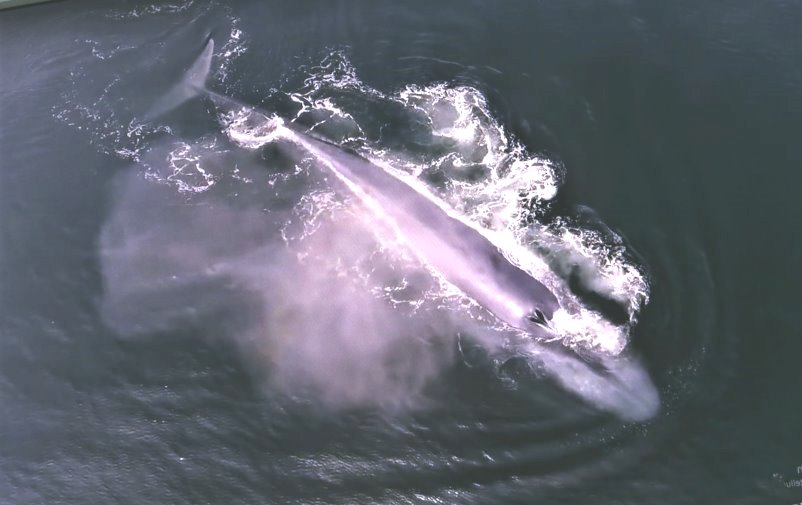 World´s largest animal, the blue whale.
World´s largest animal, the blue whale.
We know this through military hydrophones (microphones under water), which are usually meant to discover Soviet submarines. Acousticians were able to follow a single blue whale for 34 days over a distance of 1500 miles within the mid-Atlantic. Just by its sound pattern. Such a whale can sing for days on end, with only a few interruptions for breathing.
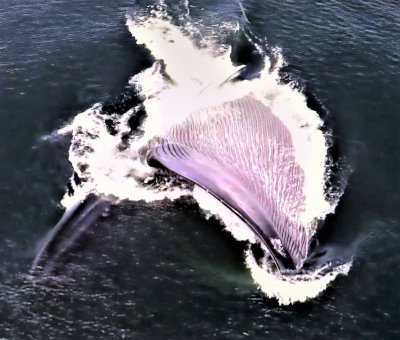 Picture left: Blue whale at lunge feeding. They bow always to their right side. Lower jaw and throat pouch are seen here at the right.
Picture left: Blue whale at lunge feeding. They bow always to their right side. Lower jaw and throat pouch are seen here at the right.
Blue whales, also fin and humpback whales have a special feeding technique called lunge feeding (picture above). If they view prey, they speed up to about 8 mph. Shortly before they reach the swarm they open their lower jaw widely. The throat pouch opens through the water pressure, and an enormous amount of krill or small fishes comes inside. Through this action the speed is slowed down to 4 mph.
A single gulp of a blue whale can contain 60 to 80 tons of water and prey, more than the volume of the whole body. Therefore only swarm animals are considered as prey: herring, mackerel, krill, sardines. Lunge feeding is an extraordinary efficient way of hunting. For/Considered smaller swarms it´s more trouble then it´s worth: The whales cold-shoulders it.
Their 90 feet body needs a lot of air for breathing. The blowhole of the blue whale is huge: A man could/would be able (to) slip in.
Sperm whales, Physeter Macrocephalus
Sperm whales are among the most extraordinary animals on this planet. They´ve got the biggest brains in the world, six times bigger than humans. Maybe they´re not six times smarter than us. At last that giant brain has to serve a giant body: Females put around 15 tons on the scale, males even up to 50 tons, as much as two fully loaded trucks.
Giants of the deep sea
About half of its life a sperm whale spends way down under water - usually 1000 to 4000 feet below – searching for giant squids (also very smart animals). The pressure down there is unimaginable for us, also the absolute gloominess. How do the animals orientate themselves? How do they find their prey? How can they withstand the pressure? The answer simply is: We know almost nothing about it.
Through whaling of the former centuries we know at least that the bulky snout of the sperm whale contents an oil, which reminded the whalers of their own sperm. So that´s where the name comes from. The oil was treasured as fuel for lamps those days. Therefore these animals were hunted mercilessly.
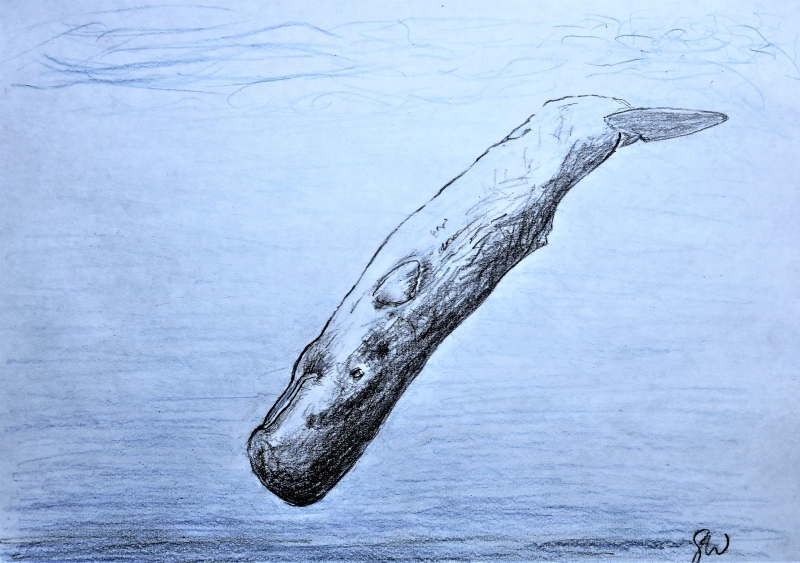 Sperm whale diving headfirst (drawing: Georg Wübbolt)
Sperm whale diving headfirst (drawing: Georg Wübbolt)
Song of the whales
We also know that sperm whales - like almost all whales and dolphins - produce sounds. Klicks, buzzing, creaking, calling and so on. Sometimes as loud as a starting airplane. Only since sonic depth finders and sonars have been invented, we humans can adumbrate, what the whales are using it for since millions of years. And they are able to know much more, of what we - I repeat it - don´t have a clue.
When sperm whales are chasing, it clicks out of their spermaceti organ (their oil filled snout) „click-click-click…“ in more or less regular intervals. By this way they probably "see" or scan their prey precisely even in complete darkness. They know exactly whether it is a giant quid („Yuppee!“), or a not so tasty animal. They will pinpoint and eat it. Down there. Markings of suckers on the whale´s skin indicate that this is sometimes a fiery fight.
One dive of a sperm whale lasts approximately 45 minutes, sometimes more than an hour. When they approach the surface, they usually remain there for a couple of minutes. They do nothing but breathe, probably in oder to refill their oxygen"tanks". And maybe to schmooze a little bit?
Every once in a while larger groups rest together at the surface. Somtimes for only 15 minutes, sometimes for hours. Then they lay quietly next to each other and utter some cozy sounds. They´re seeking for body contact and nuzzle to one another. Or they just poke their head out of the water.
Family matters
Carribbean sea north of the Dominican Republic. Here lives a quite well researched family of seven sperm whales. Scientist named each of them: Mysterio, Pinchy, Tweak, Enigma. That group lives and chases together. Sometimes they spread out for many miles. But they always remain in contact and will meet at a certain point alltogether.
In sperm whale communities the mothers are in authority. That applies also with many of the more intelligent animals like elephants, wolfes and killer whales.
Sperm whales alternate in babysitting. The little ones cannot dive as long and deep as their mothers. And they need protection from those always hungry killer whales and sharks.
If sperm whale mother Pinchy undertakes long divings. Her upspring called Tweak must remain at the surface. It will be protected by Mysterio, and also wet-nursed. Thereafter it´s the other way round: Mysterio goes hunting, and Pinchy takes care of the little ones. Breeding is teamwork.
This sperm whale community is used to visitors on boats. They obviously don´t object whale watchers. If one approaches carefully, the animals remain quiet and relaxed.
Hal Whitehead and Luke Rendell are two marine biologists, who try lifelong to figure out the secrets of sperm whales: „Unfortunately we cannot see how they chase under water, but we see their defacation: Sometimes brown patches appear on the surface behind the whales, when they start their deep divings. First of all we photograph their tales, in order to identify the whale. Then we hope to find a brown cloud at its diving point. Because what comes out, must have come in before. By the amount of this brown secretion we can guess, how successful the whale was in his hunt underwater .“
Source: Whitehead/Rendell: „The Cultural Lives of Whales and Dolphins“, The University of Chicago Press, 2015
Attacks of killer whales
Sperm whales are always on the move. they travel hundreds and thousands of kilometers through the seas. And they defend each other together. These animals have been watched repeatedly, how they jeopardised themselfes in order to help other group members. For example if being attacked by killer whales.
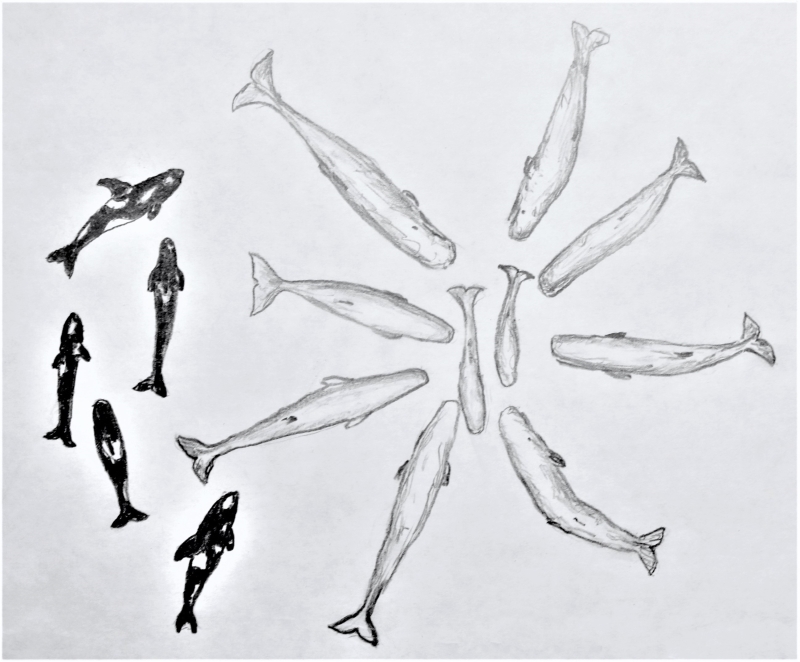 Killer whales attacking sperm whales (drawing: Georg Wübbolt)
Killer whales attacking sperm whales (drawing: Georg Wübbolt)
Astonishingly killer whales are friendly towards us humans, but they carry their names for a good reason: They´re the only animals that can kill a whale. Several of these attacks have been monitored at the coast of California.
Scientists watched five killer whales swimming towards a small group of sperm whales. These sperms must have raised alarm immediately, because right away some other collegues joined them. Together they formed a circle around the youngsters (picture above), some with their heads above, some tail slapping on the surface, as if to (they would) demonstrate their force.
One single female killer whale swam towards a sperm whale and bit it. Now four other distant sperm whale groups dashed forwards and reinforced the main group. For about an hour more sperm whales were arriving, until the group consisted of about 50 animals. In view of this enhencement the killer whales withdraw from their prey. With humans one would call such a behavior heroic. Source: Carl Safina „Die Intelligenz der Tiere“, Verlag C.H. Beck, 2017
Sperm whales stealing from fisher nets and longlines
Sperm whales steal fish, meanwhile worldwide. Around 1995 a clever sperm whale found out that it is much easier to thieve fish floundering in the net or at the hood, insteadt of chasing itself laboriously. That got around quickly between other sperm whales. A gang of ten male robbers is dreaded in the Alaskan waters, called by the fishermen just "bad boys". A soon as these animals get aware that the fisher boats are shifting down the gear in order to drop their longlines, they swim there and just wait.
But caution! The fish is caught on a barbed hook, which could lead to painful injury in the sperm whale´s mouth. But this problem has been solved sneakyly: The whale swims to the line, packs it with its mouth and pulls it a coulpe of times. Thus the fish drops from the line, and the whale can eat it. How do we know that? Through a camera fixed on the longline. "When we saw that, it became clear, how damned clever those animals are," a fisherman says.
-
Foto bw: Pottwal steals fish (sehr klein).
And it´s getting more and more. The elderly teach the youngsters how to attack fisher boats the best. A sperm whale eats up to one ton of fish per day. At hungry days it accumulates easily to 20 tons of stolen fish. What could one do about it?
Latterly one tries a possibly successful counteraction: The whales are being armed with a GPS transmitter. If the fisherman identify them, they could make a wide curve around the whale. It even works in a few cases.
It can only be a drop in a bucket, because it is completely illusive to sender some hundreds of those robber whales. This war is not over yet. Let´s see; maybe the "bad boys" found already an answer to that.
Source: - „Sperm Whale und Fishery: Alaska Perspective of a Global Problem“ - Barbara Kollmann: „Soko Wal“, in: Welt am Sonntag, 15.2.2015
Humpback whales, Megaptera novaeangliae
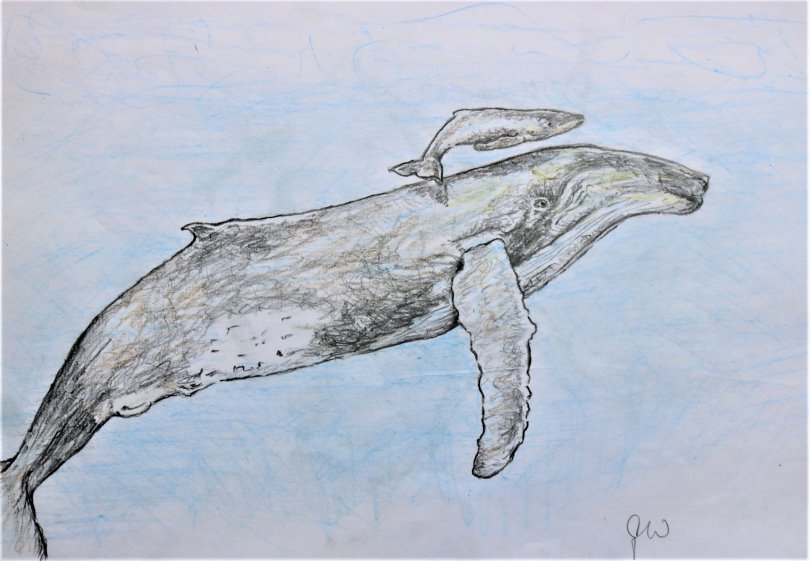 Humpback whale with a newborn (drawing: Georg Wübbolt)
Humpback whale with a newborn (drawing: Georg Wübbolt)
Humpback whales are the sporting aces among all whales. Lifting their heavy body out of the water - nobody who has discovered that will ever forget. Nobody knows exactly why they do it, but it´s probably out of sheer joy: A little show to impress females and males (and humans).
-----------------------------------------------------------------------------------------------------
Scientists always have suspected that the noise of motor ships and the sonars of submarines are very much disturbing whales and are also responsible for strandings. Now there is a proof, a singular but very explicit one:
An island called Jan Mayen in the North Atlantik, between Norway and Greenland. Here scientists have assembled a Northern Bottlenose Whale (Hyperoodon ampullatus) with a transmitter to record its route and diving depth. In the fascinating book of James Cheshire and Oliver Uberti* we read: „[The scientists] pumped noise into the ocean for 35 minutes. At a loudness of 98 decibel under water – comparable with the sound of a submarine driving by – the whale turned around and came curiously to their ship. As soon as they increased the noise up to 130 decibel, the whale turned at a 180 degrees and performed the longest and deepest dive ever being recorded for its species: 94 minutes, 2339 Meter.
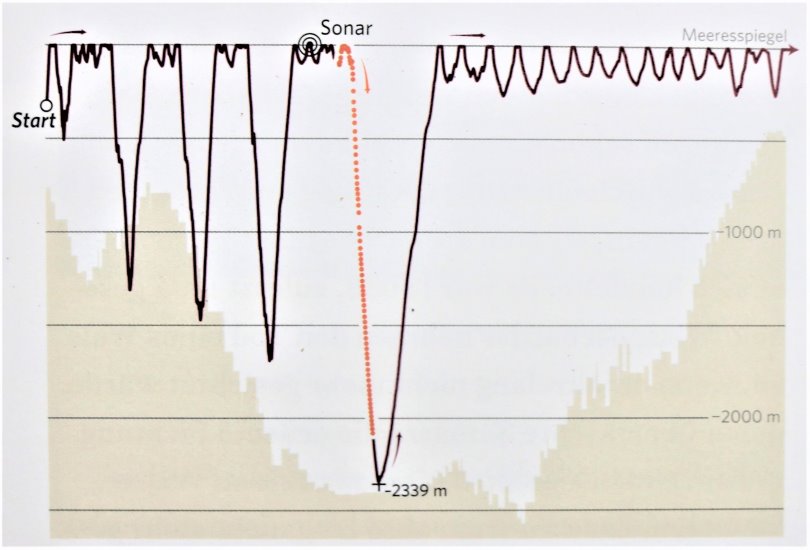 Dotted orange line: Flight and deep dive of the whale; then trying to rush away.
Dotted orange line: Flight and deep dive of the whale; then trying to rush away.
During the heavy noise section the whale emitted no clicks or buzzings as he had often done before. The next days scientists recognized much less whales in that area.
*Source: James Cheshire / Oliver Uberti: „Die Wege der Tiere“, Carl Hanser Verlag, 2017
Responsible whale watching of these days contributes very much to investigate and better understand those fascinating animals. And first of all helps to protect them and their environment.
These and more informations you can read in Georg Wuebbolt´s book/E-book:
Whale Travel – Carribbean: Dominican Republic and Puerto Rico - Flights, hotels, camping, rental cars, restaurants, tour providers
Book/E-book to be published in 2018.
Telephone: +49 4133-4451
Mobile: +49 175-2013 507
Email: This email address is being protected from spambots. You need JavaScript enabled to view it.

